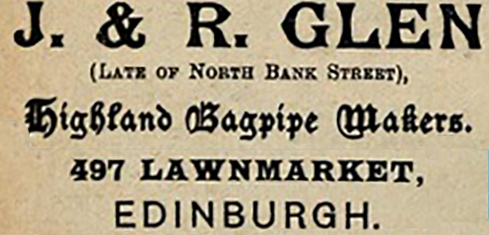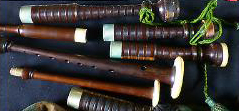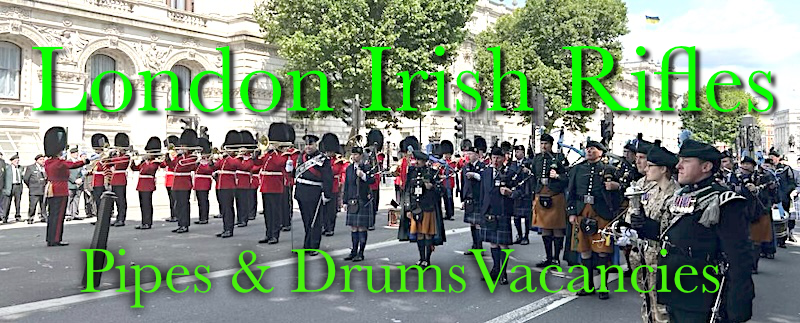 The following is taken from the catalogue of the noted Edinburgh pipe maker and music publisher J&R Glen of 497 Lawnmarket. Headlined ‘Important Notice’ it was issued by them in 1929…..
The following is taken from the catalogue of the noted Edinburgh pipe maker and music publisher J&R Glen of 497 Lawnmarket. Headlined ‘Important Notice’ it was issued by them in 1929…..
The particular attention of Pipe Band Presidents is drawn to Army Council Instruction No.544 of 19th December 1928 authorising the change in all army bands from High Pitch to Low Pitch. This instruction must, in time, effect the Pipe Band as well as the Military Band, and where massed bands play frequently together the necessity of the change is more urgent.
The High Pitch Chanter hitherto supplied cannot be played at Low Pitch no more than a Bb clarinet can play A natural parts. We would remind Pipe Band Presidents and Pipe Majors that we have , for a number of years now, produced a Low Pitch Chanter (A=439 v.r.) more particularly for the use of stage artists who desire to play along with Low Pitch orchestras.
This chanter is by no means an experimental one, but is built on well-defined acoustic principles and has been to our entire satisfaction in our Staff Orchestra for many years, where our specially trained pipers play regularly along with other Low Pitch orchestral instruments. The Service also supplies some very successful examples of combined playing of Military Band with pipes.
Our reputation for chanters is built on quality only, and has been the object of our special attention for over 100 years now. We refer readers to page 14 [of their catalogue] for prices and details. Allowances can be made for ivory or silver soles in present High Pitch chanters, or these same soles can be mounted to Low Pitch chanters (the wood only).
[wds id=”6″]
The Effect on Civilian Pipe Bands
The change from High Pitch to Low Pitch need not affect civilian Pipe Bands except when they have to play along with Service Bands at Highland Gatherings and other massed performances. Low Pitch (or New Philharmonic A = 439 v.r. or Normal Diaps. A = 435 v.r.) has been the universal pitch on the continent and in America for many years, and we confidently recommend our low Low Pitch Chanter to all who desire to play along with other instruments.
Some people believe that pipes cannot be played along with any other instruments, but this mistake generally arose , in the past, from a misunderstanding or lack of knowledge of the true meaning of Pitch among pipers generally. We can, from our own experience, recommend piano and all other orchestral instruments as suitable accompaniment to the pipes, always provided that the Musical Director understands exactly what he is doing, and scores suitable parts for the orchestra. It is also essential that the piper takes the trouble to understand exactly about pitch, and takes a wider view of music generally.
The editor comments: Anyone who has tried lowering even a very old pipe chanter to concert A will have found great difficulty in maintaining that pitch. I tried it once using an ancient Henderson chanter and just about managed it. The occasion was a performance of Sir Peter Maxwell Davies’s ‘Orkney Wedding, with Sunrise’ which he mistakenly scored in A major. (Not the first classical musician to confuse the key we write our music in with the actual pitch of the instrument.) I was rescued on that occasion by Pipe Major Iain MacDonald of the Neilston band who along with the late George McIlwham is/was a veteran of the Orkney Wedding gig.
Chanters down in A sound rather weird and have that continental bagpipe sound, the tone you get with those soft toned Breughel types. I don’t believe the great Highland bagpipe was ever meant to sound like that. Bb sounds flat to today’s high pitched ear but still has that characteristic Scots bagpipe sound – no mistaking it.

Given that brass instruments are in Eb and therefore suited to the Bb chanter, it makes me wonder at how the military back in the 1920s opted for concert A. Today of course Bb is the accepted key for all mil/pipe band combos and our excellent bagpipe manufacturers have risen to the challenge making chanters in that key to great success and satisfaction of those doing tattoos etc.
I’d be interested to hear from other pipers who have had to do the concert A adjustment to see how they got on and also from anyone who has played or owns one of Glen’s A chanters. I presume the finger spacing must have been rather wide.
• Read more about Glen’s courtesy the National Museums of Scotland here.
[wds id=”10″]

















The tone of a chanter is down to the reedmaker and chanter maker: https://open.spotify.com/track/7lFDuyE6EFRw7EBHUkS2dC
The pitch of an A in Britain was 452 until the abandonment of “old philharmonic” pitch in the 1890s for “new philharmonic pitch” of A=439. This took a long time to enter widespread usage, and high pitch was still common in (non military) brass bands into the 60s. The 440 standard dates from 1939 and was widely adopted as an international standard after the war.
The modern chanter pitch is most likely J&R Glen’s 452 chanter inflated upwards since the dawn of the pipe band competition era. Unless anyone has a catalogue where they offer B flat chanters?
Intriguing the level of detail this goes into about ensemble performance though. Especially the mention of the “Staff Orchestra”.